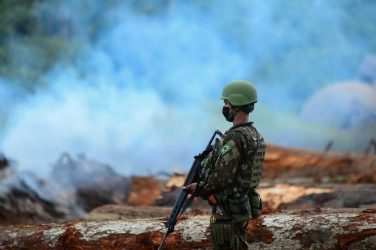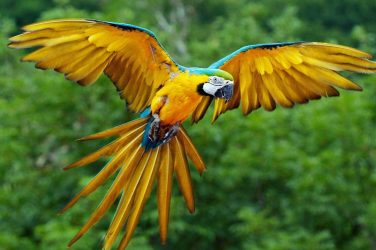The first pictures of a huge coral reef system discovered in the Amazon last year have been released by Greenpeace. The Amazon Reef is a 9,500 sq km system of corals, sponges and rhodoliths, the environmental group says.
The reef is almost 1,000 km long, and is located where the Amazon River meets the Atlantic Ocean. Oil drilling could start in the area if companies obtain permits from the Brazilian government, the group warns.
“This reef system is important for many reasons, including the fact that it has unique characteristics regarding use and availability of light, and physicochemical water conditions,” researcher Nils Asp, from the Federal University of Para, said in a statement.
“It has a huge potential for new species, and it is also important for the economic well-being of fishing communities along the Amazonian coastal zone.”
“Scientists were surprised by the discovery, in April 2016, as they thought it was unlikely that reefs would be found it the area given unfavorable conditions,” they said in a paper in the scientific journal Science Advances. The reef ranges from about 25 meters to 120 meters deep.
Asp now says that his team wants to gradually map the system. At the moment, only 5% of it has been mapped. “Our team wants to have a better understanding of how this ecosystem works, including important questions like its photosynthesis mechanisms with very limited light.”
But Greenpeace says drilling in the area means a “constant risk of an oil spill”.
Campaigner Thiago Almeira said environmental licensing processes for oil exploration there are already under way.
“The Cape Orange National Park, the northernmost point of the Brazilian state of Amapá, is home to the world’s largest continuous mangrove ecosystem and there is no technology capable of cleaning up oil in a place of its characteristics,” the group said.
“In addition, the risks in this area are increased due to the strong currents and sediment that the Amazon River carries.”
The group said that, so far, 95 wells have been drilled in the region, and 27 of them were abandoned as a result of mechanical incidents – the rest due to the absence of economically or technically viable gas and oil.
A First-Person Account
Thaís Herrero, a Communications Officer on board the Greenpeace Esperanza, thus described the significance of Greenpeace’s discovery:
In the far north of Brazil, where the Amazon River meets the sea, there is a newly-discovered natural treasure – a hidden coral reef in a region where no one thought possible. Because muddy water from the Amazon River clouds the sea surface, almost no light reaches the reef making finding a reef with a complex marine life there unlikely.
But that is where the Amazon reef was found – a unique and very special discovery. And it is huge! We are talking about 9,500 square kilometers of formations including giant sponges (which are longer than 2 meters/6.5 feet) and calcareous algae, called rhodolith.
The discovery of this reef was announced in April 2016 when a group of scientists published an article about it. They believe that the Amazon reef, which spans from Brazil to the border with French Guiana, could be a new marine biome . They continue to study the reef and the new species found there.
However, this unique treasure is already under threat. The mouth of the Amazon River is the next frontier for oil exploration in Brazilian waters. Oil companies Total and BP want to start exploratory drilling in the area. One of the blocks of oil owned by Total is just eight kilometers from the reef, making drilling there risky business and the environmental licensing processes are already underway.
Drilling there means an imminent and constant risk of an oil spill. This is a threat not only to the reef, but to the ecosystem of the basin of the Amazon River mouth.
This area is a crucial habitat for the American manatee, the yellow-spotted Amazon river turtle, and the giant river otter – species that are already at some risk of extinction, according to the 2014 IUCN List (International Union for Conservation of Nature).
Our first task is to go see the Amazon reef and share what we find with you! – so the Esperanza is embarking will go on an expedition to see the reef underwater for the first time. The crew and marine life experts will travel to the depths of the Atlantic ocean to explore the reef up close from small submarines. Stay tuned to see what we find!
It will be an unprecedented and very important mission to ensure the protection of the reef and the Amazon River mouth and we need your help! Demand that these companies give up oil exploration in the area. And follow the Esperanza in Brazil in the coming weeks.














